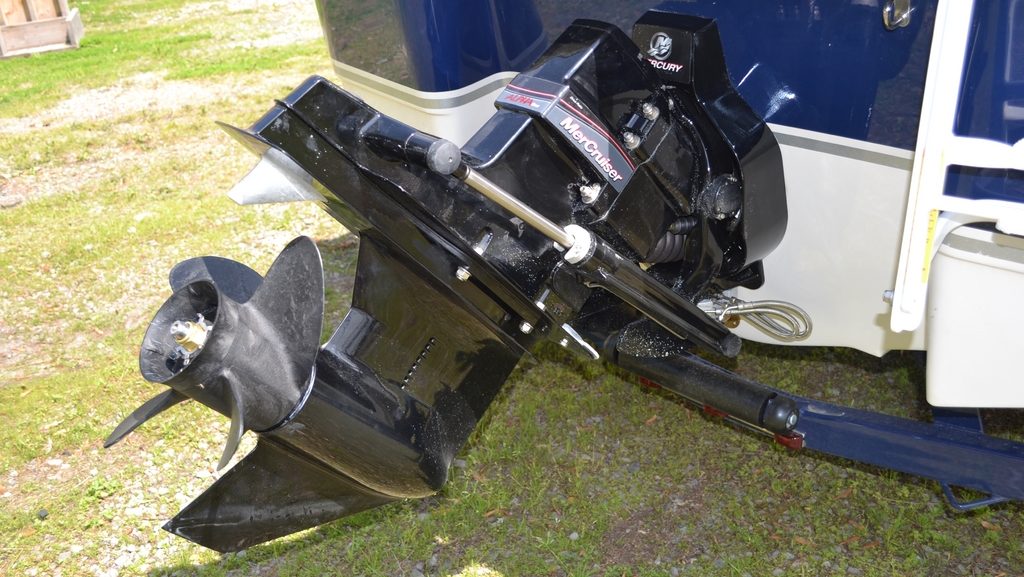This article addresses the different drive units to choose from when buying a boat. In recent years, engine manufacturers have been offering – and promoting the virtues of – engines with twin-prop drives (such as the Volvo Duo Prop and Mercruiser Bravo III) as opposed to single-prop drives (such as the Mercruiser Alpha, Bravo I, Bravo 2 and Volvo Penta SX). This is not a matter of comparing the quality of these manufacturers’ products, but rather it’s about understanding the different characteristics and applications of these two drive types.
What is a drive?
A drive is a marine propulsion unit that creates a Z shape with the engine. It’s the part that is submerged in the water and transmits power from the engine to the propeller. Often called a “sterndrive,” it acts as the boat’s rudder and includes a power trim, stabilizing mechanism that helps lift the boat at different speeds, thereby decreasing contact with the water surface.
Single-prop drives
Generally, single-propeller drives are used on boats measuring 23 feet (7 metres) or less, as the engine, weight and hull shape do not require as much power to lift out of the water. When used on boats in this category, single-prop drives can actually bring you to higher maximum speeds than a twin-prop drive, plus they are more suitable for towing one or two skiers.
Quite a wide range of drives is available for cruisers measuring 26 to 29 feet and weighing 6,000 to 8,000 pounds. That said, some manufacturers try to keep their boat/engine pairs affordable by producing a large engine block coupled with a single-prop drive. When this is the case, the propeller’s diameter is larger and its pitch is decreased, as this helps you get on plane. Another option to pair the engine with a twin-prop drive, as this greatly improves thrust and performance at cruising speed. And finally, a third option for this category is to have two medium-power engines (usually V6s) with two single-propeller drives. In my opinion, this set-up makes a lot of sense when you consider how much torque this type of boat requires. The torque from the two engines results in better lift, more power at all speeds and improved control when docking.
For the big boys measuring 29 feet and tipping the scales at 10,000 pounds (more than 4,000 kilograms), I naturally prefer twin-propeller drives, regardless of the engine type.
Single-prop drives and pitch
Single-prop drives can be equipped with any one of a vast choice of aluminum or stainless steel propellers. Therefore an engine/drive may have several different propellers, each with a different pitch. That way, you can change the propeller according to your needs. For advice on this matter, I recommend that you talk to your local boat dealer. But any propeller that allows you to attain the manufacturer’s maximum recommended rpm is a good propeller (in most cases, it’s between 4,500 and 5,000 rpm).
Twin-prop drives
So what’s the story with twin-prop drives? These units have two counter-rotating propellers to maximize the engine’s horsepower. Thus, these drives are heavier, more powerful and more robust than their single-prop counterparts.
Twin-prop drives are usually used when power is deemed more important than speed. They are therefore a better option when you want extra start-up power or to run at lower revs when carrying heavy loads. Example: a 24-foot express cruiser (approximately 5,800 lbs.) equipped with a 5.0L engine and a twin-prop drive will get better performances than it would with a 5.7L engine and a single propeller drive. In this case, it’s not about the engine, it’s all about the drive!
Another advantage of twin-prop drives is that they provide added stability at low revs, tracks better at cruising speed and respond more aggressively in reverse or other manoeuvres, such as passing through locks or docking. And since you can maintain your speed at lower revs, twin-prop drives also translate into better fuel economy – although this aspect is hard to quantify given that other factors come into play. It’s hard to calculate a percentage on fuel savings, as each case has unique variables.
Twin-prop drives and pitch
All twin-prop drives are made from stainless steel. Selection is limited and replacement costs are significantly higher as they are sold in matched sets. Plus, before you change the pitch of your propellers, I strongly recommend that you get advice from a specialized technician or boat dealer.
Other factors to consider
At first, it might seem that twin-prop drives offer a clear advantage over their single counterparts. But it’s actually more about their applications. And all other factors aside, a twin-prop drive costs anywhere from $1,800 to $2,500 more than a single one – and when you consider that they are usually paired with bigger engines, the difference can climb to $4,500. Then there are repair costs. Fixing a broken twin-prop drive will cost you a lot more, as the mechanics are more complex and the fact that the base of the drive includes an extra gear to get the two propellers to contra-rotate.
Conclusion
When determining whether you want a single- or twin-prop drive, consider what you want to use it for. In some cases, there’s no question, whereas other boats allow the buyer some latitude. As a final consideration, you should know that your boat’s resale value will be higher when equipped with a twin-prop drive.

